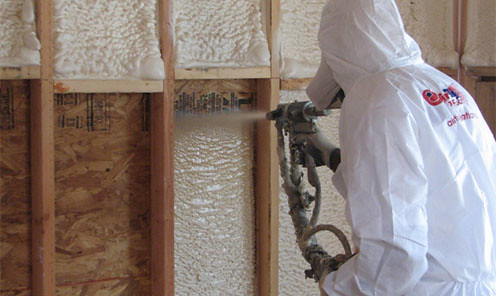
When buying a house, there are countless factors to consider—location, price, size, energy efficiency and more. One increasingly common feature in modern or renovated homes is spray foam insulation. If you’ve come across a property with this type of insulation and are wondering whether it’s a smart purchase, this blog post will help break down the key points.
What is Spray Foam Insulation?
Spray foam insulation is a modern insulation material that is applied as a liquid and expands to form a rigid, airtight seal. It is typically made from polyurethane or isocyanate, and there are two main types: open-cell and closed-cell foam. Open-cell foam is lighter and more flexible, while closed-cell foam is denser and provides greater insulation.
Unlike traditional insulation materials such as fibreglass or mineral wool, spray foam fills all gaps and crevices, making it highly effective at preventing air leaks and enhancing energy efficiency. Its popularity has grown in recent years due to its performance and versatility in a variety of applications, from roofs and walls to lofts and basements.
Is Spray Foam Insulation Good for a House?
Spray foam insulation offers numerous benefits for homeowners. It provides excellent thermal insulation, helping to reduce energy bills by maintaining a consistent indoor temperature. Its air-sealing properties also prevent draughts and improve overall comfort. Additionally, spray foam can act as a moisture barrier, reducing the risk of mould and damp.
For properties in the UK, where older homes often suffer from heat loss and high energy costs, spray foam insulation can be an attractive upgrade. However, it’s not without its drawbacks. Improper installation or the use of poor-quality foam can lead to issues such as off-gassing (the release of chemicals into the air) or damage to the building’s structure over time.

Concerns with Spray Foam Insulation in Homes
One of the biggest concerns with spray foam insulation is its impact on property value and mortgage eligibility. Some lenders in the UK are wary of homes with spray foam insulation, especially if it has been applied to roof timbers. This is because spray foam can trap moisture, potentially leading to wood rot and compromising the roof’s structural integrity.
Additionally, if the insulation prevents a surveyor from inspecting the roof during a home valuation, it may raise red flags. This could result in the lender refusing to offer a mortgage or requiring an independent assessment, which can delay the buying process.
What to Do When Buying a House with Spray Foam Insulation
If you’re considering a home with spray foam insulation, take these steps to ensure it’s a wise investment:
- Request Documentation: Ask the seller for details about the insulation, including the type of foam used, the installer’s qualifications, and any warranties or guarantees.
- Conduct a Survey: Hire a surveyor who is experienced in assessing properties with spray foam insulation. They can identify any potential issues and provide a report for your lender, if necessary.
- Check the Ventilation: Ensure the house has proper ventilation to prevent moisture build-up, which can exacerbate problems with spray foam.
- Verify Compliance: Ensure the installation complies with UK building regulations and industry standards.
Spray foam insulation can be a great feature in a home, offering excellent energy efficiency and comfort. However, it’s important to approach homes with this insulation with caution, especially if it has been applied to the roof. Thorough research, professional surveys, and communication with your lender are essential to avoid potential complications. There may be loft insulation grants for you to change the insulation once you have purchased.
If you’re willing to do your due diligence, buying a house with spray foam insulation could be a sound decision. However, if there are uncertainties or red flags, you may want to consider other properties to save yourself future hassle.
By staying informed, you’ll be better equipped to make the right choice for your home and investment.

Leave a Reply